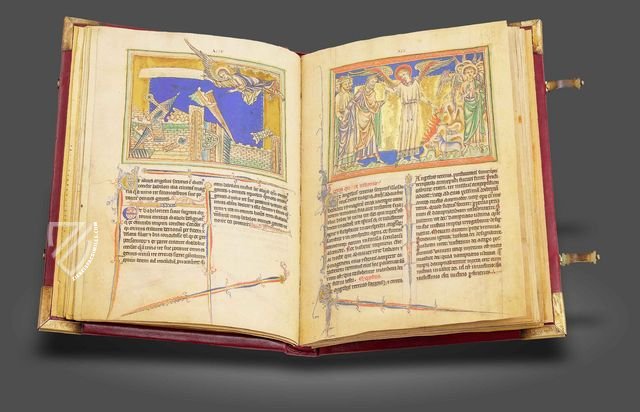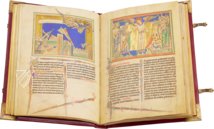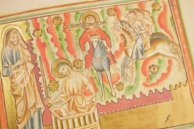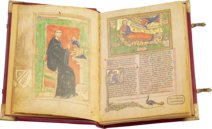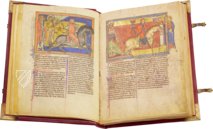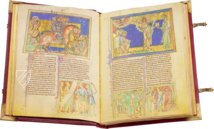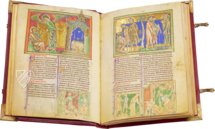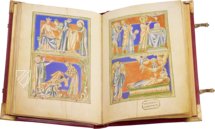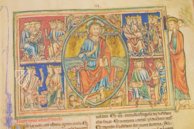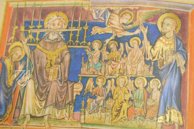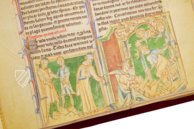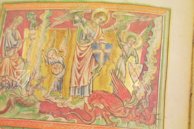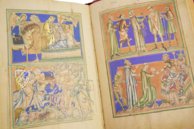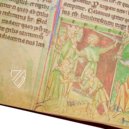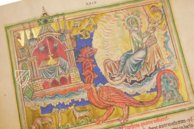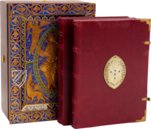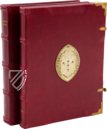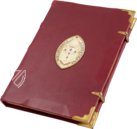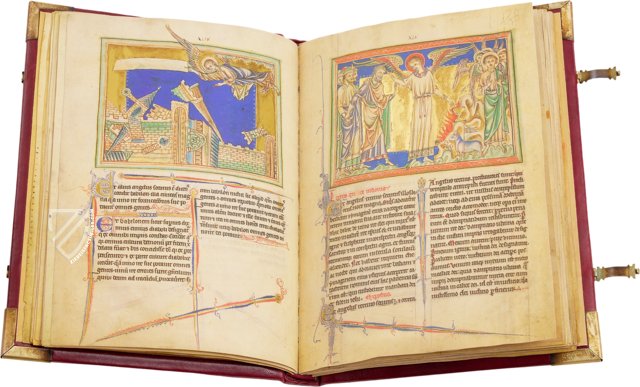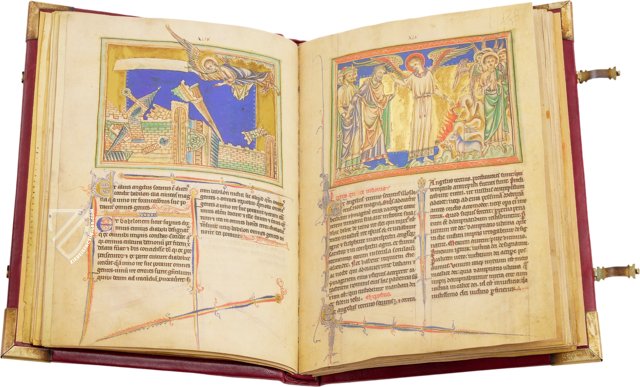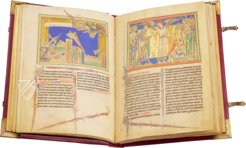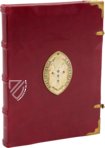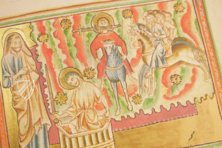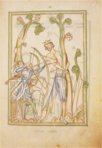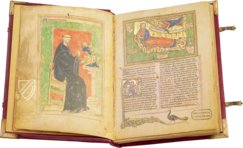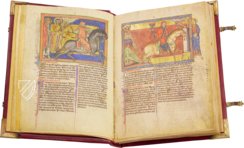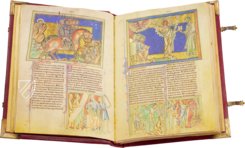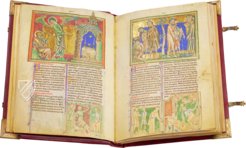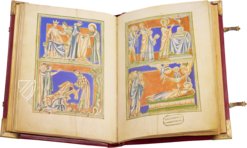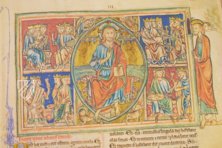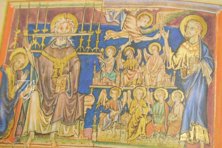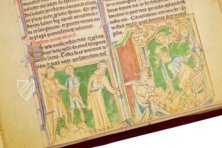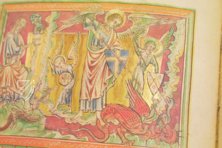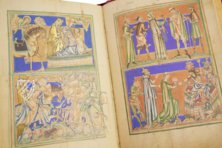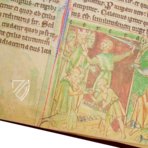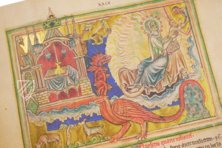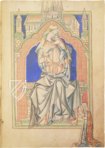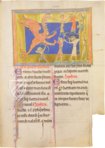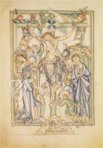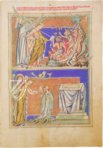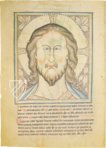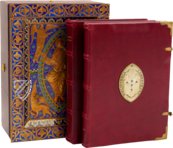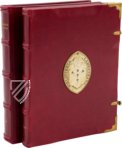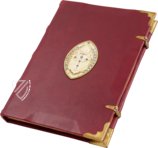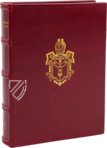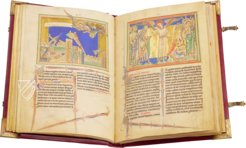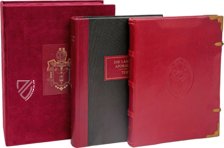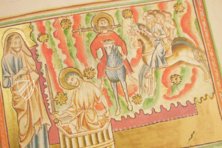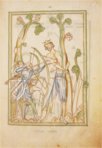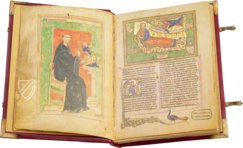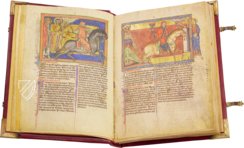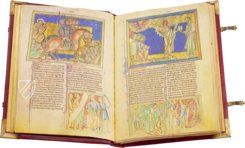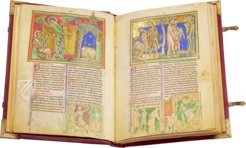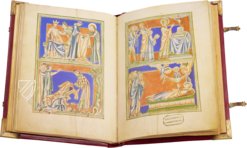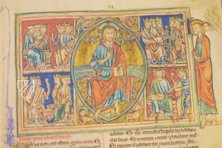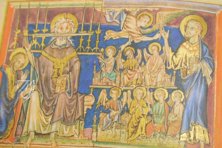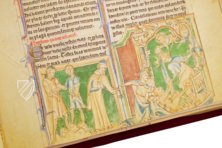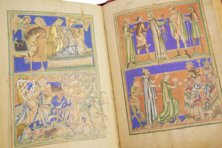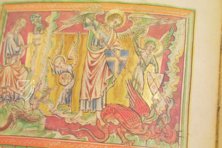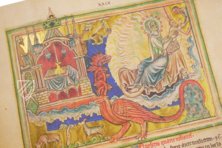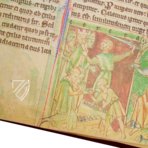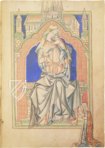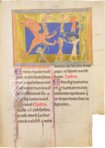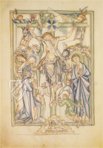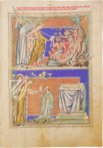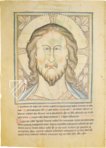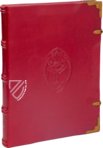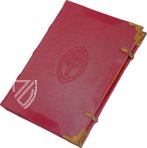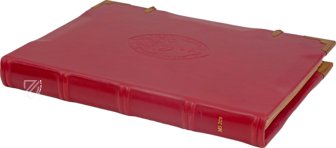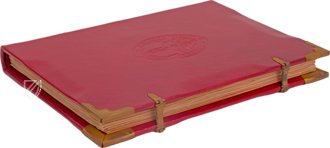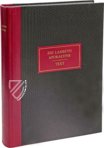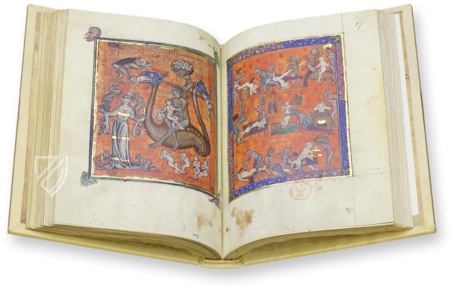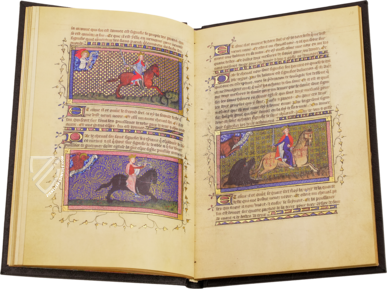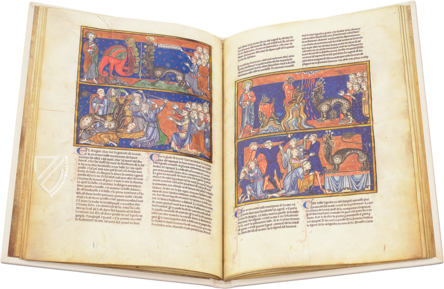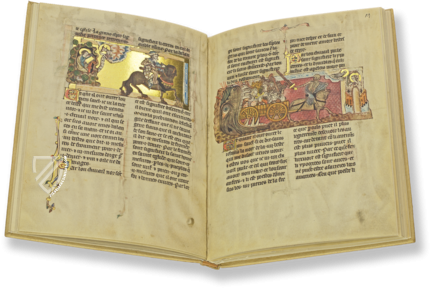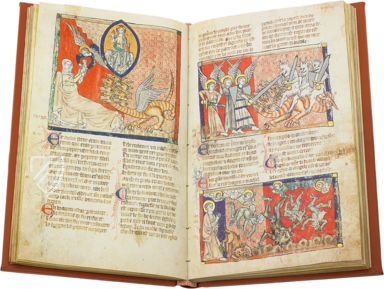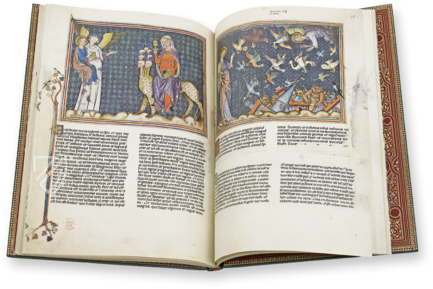Apocalypse of Lambeth Palace
(3,000€ - 7,000€)
Dating from the 13th century, the Apocalypse of Lambeth Palace captivates with its wonderful combination of splendid miniatures in the main body and colored pen-and-ink drawings in the appendix. The London manuscript in Latin was probably commissioned by Eleanor de Quincy (d. 1274), the daughter of William V Earl Ferrers of Derby (1200–1254) or his wife Margaret de Ferrers (d. 1281). The 112 pages contain the text of the Revelation of John as well as excerpts of the Berengaudus Commentary, which are artfully illuminated by 78 half-page miniatures on a 23-carat gold background and 28 colored pen-and-ink drawings. The magnificent pictorial works not only served to decorate the manuscript, but also met a didactic requirement: they could offer the reader a visual aid in understanding the eschatological material. The English Apocalypse manuscript takes its name from its current repository, the library of the Archbishop of Canterbury at Lambeth Palace.
Apocalypse of Lambeth Palace
An exceptionally attractive combination of colored pen drawings and magnificent miniatures is offered by the Apocalypse of Lambeth Palace, which originated in England between 1260 and 1270. On 112 pages, the Latin manuscript from London presents the Book of Revelation as well as excerpts from the late–11th century Berengaudus Commentary. The reader is given visual support for understanding John’s Biblical vision with a total of 78 framed, half-page miniatures with 23 karat gold backgrounds and 28 pen drawings.
A Manuscript with Pedagogical Value
Who it was that commissioned work on the Apocalypse cannot be said for certain. It was either Eleanor de Quncy (d. 1274) the daughter of William de Ferrers, 5th Earl of Derby (1200–1254) or his wife Margaret de Ferrers (d. 1281). The purpose of the manuscript was to be simultaneously pedagogical and entertaining. It was meant to educate the reader and transmit an understanding of the biblical text. The depiction of the Whore of Babylon appears to indicate a female recipient. The aristocratic lady with the devil’s cup in her hands stands on a seven-headed beast and is understood to be a warning against vanity and luxury.
Interesting Page Layout
The rectangular miniatures are always found above the two-columned text, which is almost always framed by ornamental lines in blue and red ink. Golden filigree ornaments join in, decorating the fascinating calligraphic script. This composition was particularly common in English illuminated manuscripts with hagiographic content, but also for the Apocalypses of the 12th century, e.g. the St. Alban’s Psalter or the Winchester Bible.
Red and Blue as Apocalyptic Colors
One is struck by the generous use of the colors red and blue. Together, the luminous tones create an apocalyptic atmosphere in the sometimes gruesome scenes from the story of the end of days. The primarily golden background creates a brilliant contrast to both of the colors and backlights the pictures with its heavenly glory. Additionally, each miniature is invested like a small painting and is surrounded by a simple frame of mostly blue or red.
Artful Appendix
The Apocalypse of Lambeth Palace was furnished between 1265 and 1267 with an artful appendix, which is significantly different from the rest of the décor. The last section does not contain miniatures but rather full-page colored pen drawings illustrating saints and other legends. These are also framed, provided that the depictions do not always abide within the borders and occasionally break free of them. It is likely that this later section was added and adapted with didactic drawings according to the demands and beliefs of the owner.
Codicology
- Alternative Titles
- Lambeth-Apokalypse
- Size / Format
- 112 pages / 27.2 × 19.6 cm
- Origin
- United Kingdom
- Date
- 1260–1270
- Style
- Genre
- Language
- Script
- Gothic Textura
- Illustrations
- 78 half-page miniatures and 28 full-page colored drawings
- Content
- The Revelation of St. John, excerpts from the Berengaudus commentary (late 11th century)
- Patron
- Possibly Eleanor (1274), daughter of William Ill, Earl Ferrers of Derby (1200–1254), and wife of the Earl of Winchester. Or Margaret Ferrers (1281), wife of William Ill, Earl Ferrers of Derby
- Previous Owners
- In the 17th century, the Apocalypse was in the library of the Archbishops of Canterbury. From 1648 to 1664 it was temporarily in the Cambridge university library.
Apocalypse of Lambeth Palace
Martyrdom of King Edmund of East Anglia
Although the image of a man tied to a tree being shot with arrows makes one think of St. Sebastian, King Edmund of East Anglia also died this way. In 869, the Great Heathen Army conquered his kingdom of East Anglia and Edmund was captured by the Danes. After refusing to denounce Christ, he was beaten, shot with arrows, and beheaded by the famous Viking leaders Ivar the Boneless and his brother Ubba. According to legend, searchers were able to find his head thanks to the cries of an ethereal wolf.
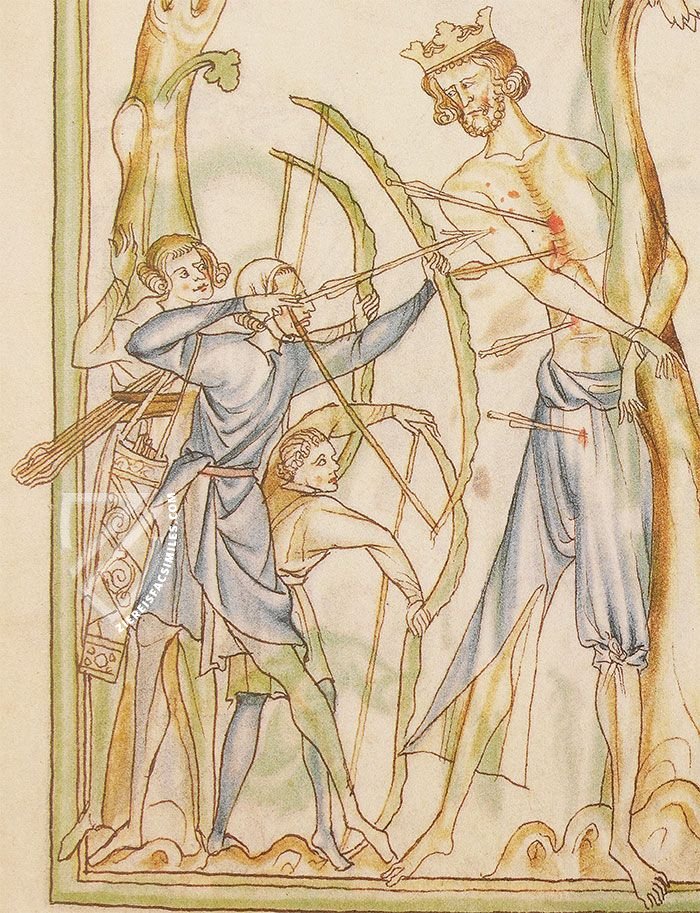
Apocalypse of Lambeth Palace
John Receives his Commission on Patmos
According to legend, the author of the Book of Revelation was visited by an angel while banished to the Greek Island of Patmos. The angel delivering this vision to John hangs in the air before a timeless and spaceless burnished gold background holding a banderole saying: “What you see, write in a book and send it to the seven churches of Asia.”
John is depicted reclining with his eyes closed, the island shaped as though it were a couch, and his toga’s stylized fall of folds reveals the shape of his long legs. Rather than depicting the seven churches of Asia and their corresponding Roman provinces, Christendom is depicted here as four islands. A ship is anchored offshore in the swirling green waters waiting to carry his work oversees.
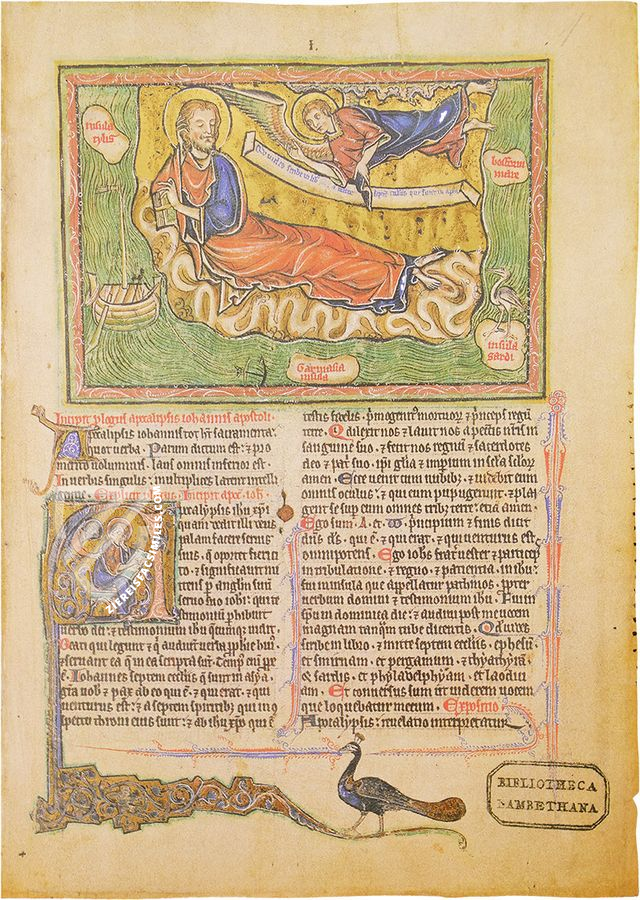
#1 Lambeth-Apokalypse (Deluxe-Edition)
Languages: German
(3,000€ - 7,000€)
#2 Lambeth-Apokalypse (Standard Edition)
Languages: German
(1,000€ - 3,000€)
- Treatises / Secular Books
- Apocalypses / Beatus
- Astronomy / Astrology
- Bestiaries
- Bibles / Gospels
- Chronicles / History / Law
- Geography / Maps
- Saints' Lives
- Islam / Oriental
- Judaism / Hebrew
- Single Leaf Collections
- Leonardo da Vinci
- Literature / Poetry
- Liturgical Manuscripts
- Medicine / Botany / Alchemy
- Music
- Mythology / Prophecies
- Psalters
- Other Religious Books
- Games / Hunting
- Private Devotion Books
- Other Genres
- Afghanistan
- Armenia
- Austria
- Belgium
- Belize
- Bosnia and Herzegovina
- China
- Colombia
- Costa Rica
- Croatia
- Cyprus
- Czech Republic
- Denmark
- Egypt
- El Salvador
- Ethiopia
- France
- Germany
- Greece
- Guatemala
- Honduras
- Hungary
- India
- Iran
- Iraq
- Israel
- Italy
- Japan
- Jordan
- Kazakhstan
- Kyrgyzstan
- Lebanon
- Liechtenstein
- Luxembourg
- Mexico
- Morocco
- Netherlands
- Palestine
- Panama
- Peru
- Poland
- Portugal
- Romania
- Russia
- Serbia
- Spain
- Sri Lanka
- Sweden
- Switzerland
- Syria
- Tajikistan
- Turkey
- Turkmenistan
- Ukraine
- United Kingdom
- United States
- Uzbekistan
- Vatican City
- A. Oosthoek, van Holkema & Warendorf
- Aboca Museum
- Ajuntament de Valencia
- Akademie Verlag
- Akademische Druck- u. Verlagsanstalt (ADEVA)
- Aldo Ausilio Editore - Bottega d’Erasmo
- Alecto Historical Editions
- Alkuin Verlag
- Almqvist & Wiksell
- Amilcare Pizzi
- Andreas & Andreas Verlagsbuchhandlung
- Archa 90
- Archiv Verlag
- Archivi Edizioni
- Arnold Verlag
- ARS
- Ars Magna
- ArtCodex
- AyN Ediciones
- Azimuth Editions
- Badenia Verlag
- Bärenreiter-Verlag
- Belser Verlag
- Belser Verlag / WK Wertkontor
- Benziger Verlag
- Bernardinum Wydawnictwo
- BiblioGemma
- Biblioteca Apostolica Vaticana (Vaticanstadt, Vaticanstadt)
- Bibliotheca Palatina Faksimile Verlag
- Bibliotheca Rara
- Boydell & Brewer
- Bramante Edizioni
- Bredius Genootschap
- Brepols Publishers
- British Library
- C. Weckesser
- Caixa Catalunya
- Canesi
- CAPSA, Ars Scriptoria
- Caratzas Brothers, Publishers
- Carus Verlag
- Casamassima Libri
- Centrum Cartographie Verlag GmbH
- Chavane Verlag
- Christian Brandstätter Verlag
- Circulo Cientifico
- Club Bibliófilo Versol
- Club du Livre
- CM Editores
- Collegium Graphicum
- Collezione Apocrifa Da Vinci
- Comissão Nacional para as Comemorações dos Descobrimentos Portugueses
- Coron Verlag
- Corvina
- CTHS
- D. S. Brewer
- Damon
- De Agostini/UTET
- De Nederlandsche Boekhandel
- De Schutter
- Deuschle & Stemmle
- Deutscher Verlag für Kunstwissenschaft
- DIAMM
- Droz
- E. Schreiber Graphische Kunstanstalten
- Ediciones Boreal
- Ediciones Grial
- Ediclube
- Edições Inapa
- Edilan
- Editalia
- Edition Deuschle
- Edition Georg Popp
- Edition Leipzig
- Edition Libri Illustri
- Editiones Reales Sitios S. L.
- Éditions de l'Oiseau Lyre
- Editions Medicina Rara
- Editorial Casariego
- Editorial Mintzoa
- Editrice Antenore
- Editrice Velar
- Edizioni Edison
- Egeria, S.L.
- Eikon Editores
- Electa
- Emery Walker Limited
- Enciclopèdia Catalana
- Eos-Verlag
- Ephesus Publishing
- Ernst Battenberg
- Eugrammia Press
- Extraordinary Editions
- Fackelverlag
- Facsimila Art & Edition
- Facsimile Editions Ltd.
- Facsimilia Art & Edition Ebert KG
- Faksimile Verlag
- Feuermann Verlag
- Folger Shakespeare Library
- Franco Cosimo Panini Editore
- Friedrich Wittig Verlag
- Fundación Hullera Vasco-Leonesa
- G. Braziller
- Gabriele Mazzotta Editore
- Gebr. Mann Verlag
- Gesellschaft für graphische Industrie
- Getty Research Institute
- Giovanni Domenico de Rossi
- Giunti Editore
- Graffiti
- Grafica European Center of Fine Arts
- Guido Pressler
- Guillermo Blazquez
- Gustav Kiepenheuer
- H. N. Abrams
- Harrassowitz
- Harvard University Press
- Helikon
- Hendrickson Publishers
- Henning Oppermann
- Herder Verlag
- Hes & De Graaf Publishers
- Hoepli
- Holbein-Verlag
- Houghton Library
- Hugo Schmidt Verlag
- Idion Verlag
- Il Bulino, edizioni d'arte
- ILte
- Imago
- Insel Verlag
- Insel-Verlag Anton Kippenberger
- Instituto de Estudios Altoaragoneses
- Instituto Nacional de Antropología e Historia
- Introligatornia Budnik Jerzy
- Istituto dell'Enciclopedia Italiana - Treccani
- Istituto Ellenico di Studi Bizantini e Postbizantini
- Istituto Geografico De Agostini
- Istituto Poligrafico e Zecca dello Stato
- Italarte Art Establishments
- Jan Thorbecke Verlag
- Johnson Reprint Corporation
- Josef Stocker
- Josef Stocker-Schmid
- Jugoslavija
- Karl W. Hiersemann
- Kasper Straube
- Kaydeda Ediciones
- Kindler Verlag / Coron Verlag
- Kodansha International Ltd.
- Konrad Kölbl Verlag
- Kurt Wolff Verlag
- La Liberia dello Stato
- La Linea Editrice
- La Meta Editore
- Lambert Schneider
- Landeskreditbank Baden-Württemberg
- Leo S. Olschki
- Les Incunables
- Liber Artis
- Library of Congress
- Libreria Musicale Italiana
- Lichtdruck
- Lito Immagine Editore
- Lumen Artis
- Lund Humphries
- M. Moleiro Editor
- Maison des Sciences de l'homme et de la société de Poitiers
- Manuscriptum
- Martinus Nijhoff
- Maruzen-Yushodo Co. Ltd.
- MASA
- Massada Publishers
- McGraw-Hill
- Metropolitan Museum of Art
- Militos
- Millennium Liber
- Müller & Schindler
- Nahar - Stavit
- Nahar and Steimatzky
- National Library of Wales
- Neri Pozza
- Nova Charta
- Oceanum Verlag
- Odeon
- Orbis Mediaevalis
- Orbis Pictus
- Österreichische Staatsdruckerei
- Oxford University Press
- Pageant Books
- Parzellers Buchverlag
- Patrimonio Ediciones
- Pattloch Verlag
- PIAF
- Pieper Verlag
- Plon-Nourrit et cie
- Poligrafiche Bolis
- Presses Universitaires de Strasbourg
- Prestel Verlag
- Princeton University Press
- Prisma Verlag
- Priuli & Verlucca, editori
- Pro Sport Verlag
- Propyläen Verlag
- Pytheas Books
- Quaternio Verlag Luzern
- Reales Sitios
- Recht-Verlag
- Reichert Verlag
- Reichsdruckerei
- Reprint Verlag
- Riehn & Reusch
- Roberto Vattori Editore
- Rosenkilde and Bagger
- Roxburghe Club
- Salerno Editrice
- Saltellus Press
- Sandoz
- Sarajevo Svjetlost
- Schöck ArtPrint Kft.
- Schulsinger Brothers
- Scolar Press
- Scrinium
- Scripta Maneant
- Scriptorium
- Shazar
- Siloé, arte y bibliofilia
- SISMEL - Edizioni del Galluzzo
- Sociedad Mexicana de Antropología
- Société des Bibliophiles & Iconophiles de Belgique
- Soncin Publishing
- Sorli Ediciones
- Stainer and Bell
- Studer
- Styria Verlag
- Sumptibus Pragopress
- Szegedi Tudomànyegyetem
- Taberna Libraria
- Tarshish Books
- Taschen
- Tempus Libri
- Testimonio Compañía Editorial
- Thames and Hudson
- The Clear Vue Publishing Partnership Limited
- The Facsimile Codex
- The Folio Society
- The Marquess of Normanby
- The Richard III and Yorkist History Trust
- Tip.Le.Co
- TouchArt
- TREC Publishing House
- TRI Publishing Co.
- Trident Editore
- Tuliba Collection
- Typis Regiae Officinae Polygraphicae
- Union Verlag Berlin
- Universidad de Granada
- University of California Press
- University of Chicago Press
- Urs Graf
- Vallecchi
- Van Wijnen
- VCH, Acta Humaniora
- VDI Verlag
- VEB Deutscher Verlag für Musik
- Verlag Anton Pustet / Andreas Verlag
- Verlag Bibliophile Drucke Josef Stocker
- Verlag der Münchner Drucke
- Verlag für Regionalgeschichte
- Verlag Styria
- Vicent Garcia Editores
- W. Turnowski Ltd.
- W. Turnowsky
- Waanders Printers
- Wiener Mechitharisten-Congregation (Wien, Österreich)
- Wissenschaftliche Buchgesellschaft
- Wissenschaftliche Verlagsgesellschaft
- Wydawnictwo Dolnoslaskie
- Xuntanza Editorial
- Zakład Narodowy
- Zollikofer AG

